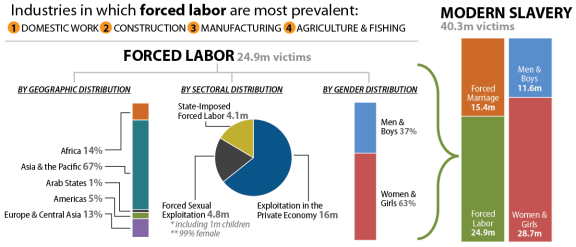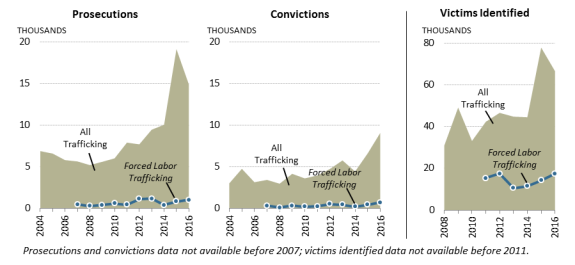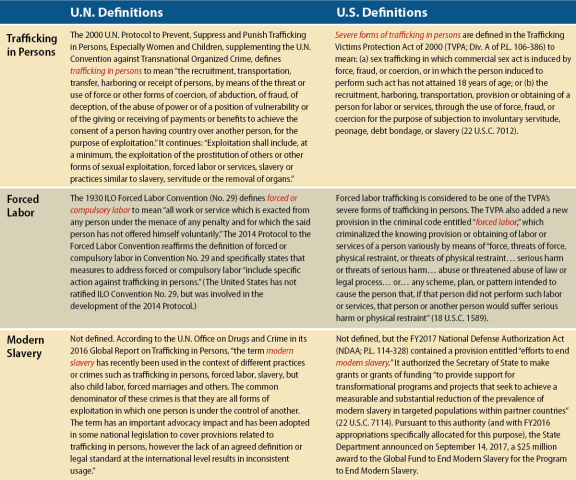Human Trafficking: New Global Estimates of Forced Labor and Modern Slavery
Introduction
As part of long-standing congressional interest in global human trafficking, some Members have consistently sought greater fidelity in quantifying human trafficking's prevalence. In September, the International Labor Organization (ILO) and the advocacy organization Walk Free Foundation, in partnership with the International Organization of Migration (IOM), released a new report on the global prevalence of modern slavery (including forced marriage) and forced labor (including sex trafficking and government-imposed forced labor). The report estimated that 40.3 million people were victims of modern slavery in 2016—including 24.9 million people in forced labor and 15.4 million people in forced marriage (see Figure 1).
The estimate was based on a new methodology, derived from multiple data sources, household surveys, probabilistic modeling, and analytic reviews of secondary sources. Using 2012-2016 as the reference period for the study, it concluded that some 89 million people had experienced modern slavery in the past five years. The report additionally stressed that its estimates are conservative, noting the lack of data due to underreporting—particularly in conflict zones (estimates of child soldiers, for example, were not included).
|
Figure 1. ILO's 2017 Estimates of Modern Slavery and Forced Labor |
 |
|
Source: CRS based on the ILO and Walk Free Foundation, Global Estimates of Modern Slavery, 2017. |
Global Estimates in Context
Estimates of human trafficking victims have varied widely and are a topic of ongoing debate. One of the earliest estimates prepared by the U.S. government in 1997 indicated that there might be some 700,000 victims worldwide. In 2005, ILO published its first global estimate of forced labor, which found that a minimum of 12.3 million people were in forced labor at any point during the time period between 1995 and 2004. The ILO revised its methodology to produce an updated global estimate in 2012, which found that 20.9 million people were in forced labor at any point during the time period between 2002 and 2011. Before the 2017 findings, the advocacy organization Free the Slaves had long estimated that some 27 million slaves worldwide. In 2016, the Walk Free Foundation estimated that 45.8 million people were held in slavery. Notwithstanding ongoing differences among various estimates, if the generally upward trend over the past two decades can be assumed to be correct, the latest figures may reinforce long-standing criticism of global efforts to identify victims and ultimately prosecute and convict their traffickers (see Figure 2). In 2016, governments around the world were able to officially identify 66,520 actual victims of human trafficking.
Defining Modern Slavery
Definitional variances complicate understanding of prevalence. In its use of the umbrella term modern slavery, a term that is not comprehensively defined in international or U.S. law, the ILO report draws attention to a broader landscape of global human exploitation, including forced marriage. The State Department's 2010 Trafficking in Persons (TIP) Report clarified that "not all forced marriages result in cases of trafficking." Yet, its 2017 TIP Report appears to use the terms modern slavery and human trafficking often interchangeably. (See also CRS Report R44953, The State Department's Trafficking in Persons Report: Scope, Aid Restrictions, and Methodology.) Similarly, recent Congresses at times have conflated the terms modern slavery and human trafficking in hearings and human trafficking legislation. The international community, too, addresses forced labor, modern slavery, and human trafficking as interrelated, but not necessarily identical, global concerns. In 2015, for example, members of the United Nations agreed to a set of 17 Sustainable Development Goals and 169 targets, including target 8.7, which committed states to "take immediate and effective measure to eradicate forced labor, end modern slavery and human trafficking, and secure the prohibition and elimination of the worst forms of child labor, including recruitment and use of child soldiers."
Implications for Congress
Whether U.S. anti-trafficking programs are intended to address the broader phenomenon of modern slavery or something more narrowly defined poses both legislative and oversight policy questions for Congress. Current bills in the House (H.R. 2200) and Senate (S. 1312) seek to reauthorize the Trafficking Victims Protection Act of 2000 (TVPA), whose authorizations for appropriations to eradicate severe forms of trafficking in persons, domestically and internationally, expired at the end of FY2017. The TVPA also contains the statutory provisions that require the State Department to prepare the annual TIP Report and rank countries on the basis of their efforts to eradicate human trafficking—provisions that several bills in the 115th Congress aim to modify. Some observers may seek clarification as to whether the TIP Report is intended to address modern slavery, generally, or the statutorily defined "severe forms of trafficking in persons" (see Figure 3). Congress may also conduct oversight of the State Department's new Program to End Modern Slavery, a recent initiative first authorized in the FY2017 National Defense Authorization Act (P.L. 114-328) and for which funding was appropriated in FY2016 (P.L. 114-113).

